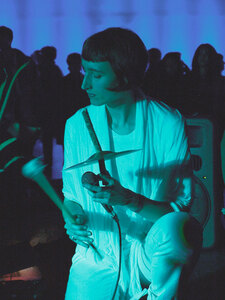MOCA opening party lets attendees make the art
Huddled beneath large tents to escape the rain while nursing extremely overpriced cocktails, some of Los Angeles’ most enthusiastic art patrons gathered at the Geffen Contemporary at MOCA for a members-only evening of art, music and communal participation.

Experimental · The evening’s musical guest Lucky Dragons — including Sarah Rara — handed out instruments to audience members. - Sunil Murali | Daily Trojan
The party, which occurred Saturday, was to celebrate MOCA’s newest exhibit, “Collection: MOCA’s First Thirty Years.”
Although MOCA’s Grand Avenue location will include an extension of the exhibit with works covering earlier 20th century modern art, the exhibit featured at the Geffen Contemporary brings together nearly 500 works from MOCA’s expansive permanent collection and spans a surprisingly short range of international contemporary art from the past 30 years.
Displayed in the new exhibit are works by well-known players in the contemporary art world — including Barbara Kruger, Jean-Michel Basquiat and Raymond Pettibon — as well as pieces from new and relatively unknown artists.
The event also featured a new-concept performance by the Los Angeles-based experimental music and art collective Lucky Dragons, helmed by key members Luke Fischbeck and Sarah Rara, a first-year MFA student in USC’s Roski School of Fine Arts.
Called Live Sprawl, the performance encapsulated the entirety of the event with multiple musical performances scattered throughout the night, large-scale video installations and ambient noise amplified throughout the outdoor gallery space.
Throughout the evening, members of Lucky Dragons roamed the gallery and outside space with saxophones and percussion instruments, setting up spontaneous jam sessions before packing up and heading to a different location within the museum.
Also featured outside the gallery was local synthesizer impresario David Scott Stone, famous for his musical collaborations with bands such as The Melvins and No Age.
Stone allowed museum goers to tinker and experiment with an impressive modular synthesizer he built himself to produce various waveforms and sounds from the machine. For a good portion of the night, groups huddled around the large machine, patching in cables and twirling various knobs to achieve a desired musical effect.
Later in the evening, Fischbeck gathered onstage in the outdoor gallery with several other members of the Lucky Dragons’ collective to begin the capstone performance of the evening.
Opening with an ambient, drone-filled piece characterized by off-beat drumming and reverb-laden vocals, the band began to set the scene for what would become an immensely captivating performance.
Skeptical attendees initially watched and stood around bewildered — was this the entirety of Lucky Dragons’ long-hyped conjunction between music and art? The partnership between the group and MOCA began to seem like an odd fit.
Yet, soon after the group began, members of the Lucky Dragons’ collective hopped offstage and roamed through the crowd, handing out an odd variety of instruments to unsuspecting viewers.
While most of the impromptu band members received percussion instruments such as Tibetan bells, gongs and tambourines, a small group of viewers huddled near the front of the stage were given a series of long, tightly coiled wires connected to a small input box which fed to a laptop. This contraption has become a staple — and a somewhat legendary component — of the Lucky Dragons’ performances.
Relying on MIDI technology and electrical resistance, the wires transform into a bizarre touch-sensitive sampler in which direct contact with one of the wires — as well as direct contact with whoever holds a wire — will generate various forms of melodic feedback.
The collective aptly calls this heavily audience participation-oriented act “Make a Baby.”
With only minimal guidance from Fischbeck, the selected audience members soon realized what the series of wires were capable of, and it only took minutes before the group of complete strangers held hands and connected the collection of strands together in varying patterns to produce a well-coordinated cacophony of sound.
Anderson and Fischbeck continued to roam around the gallery, passing out instruments and encouraging others to pick one up. The room soon became awash with a sonic melee. In one corner, a group of women took turns hitting a gong while other participants created melodies on their free recorders and watched the members of the “Make a Baby” group move their arms in bizarre patterns in order to trigger the feedback loops.
With this swift transition from solo musical performance into full-on participatory experience, Lucky Dragons allowed the audience of art appreciators to become the art itself. All of the elements of the performance for the rest of its 30 minutes were controlled not by the musical group but by the event’s attendees instead.
When the band finally silenced its laptops and drumming, many who had received instruments from the band continued to play amid enthusiastic applause from the audience until, one by one, the instruments were voluntarily returned to the stage, and the music vanished as quickly as it had developed.

i’m sorry i missed this happening. the report of it encourages me that the contemporary art world is not as dead as it looks, lost in multiplicity, ignored by all but participants in art.
with computers and television i think people are being drowned in media in their rabbit-holes.
now my ears are pricked up and i will be watching MOCA for future shindigs.
i can’t help but be reminded of the world cafe in the village, global village and “the factory”.
this could be a sign of the revival of real experiences.
s.c.